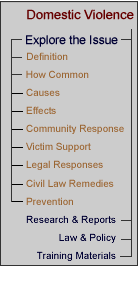|
|
|
STALKING Definition of Stalking Broadly defined, stalking is a pattern of harassing or threatening behaviors. These behaviors may including following a person, appearing at a person’s home or place of employment, making phone calls, leaving written messages or objects/gifts, sending emails, faxes or letters, and vandalizing a person’s property. Stalking often leads to serious injury or even death of the victim. Most stalkers are male, and a majority of those who are stalked are women. Although stalking of strangers does occur, in the vast majority of cases, the stalker and victim know each other. Generally, stalker and victim are current or former intimate partners. Women are often stalked by their former partners after they leave or attempt to leave their abuser. From Office of Justice Programs, Stalking and Domestic Violence (1998). Men who stalk former intimate partners are also more likely to be violent than those who stalk strangers. From Stalking Study Shows That Most Stalking Involves Intimates, Seriously Impacts Victims, and Receives an Inadequate Response, Violence Against Women 3-20 (Joan Zorza ed., 2002). Naming these behaviors “stalking” is useful in a number of ways. First, the stalking itself, not just the assault in which it often results, is a form of violence. The batterer is taking specific actions, such as calling or appearing at a place of work, that are designed to intimidate and coerce his former partner. Second, the term “stalking” identifies a pattern of behaviors that often lead to serious or fatal attacks. Identifying the pattern of behavior can therefore be useful in taking steps to prevent an assault. Third, naming this pattern of behaviors helps to convey the seriousness of these behaviors. Stalking is a combination of a number of different kinds of actions, such as telephone calls. Individually, these behaviors may appear to be innocent. Taken together, they indicate the presence of a severe threat to the victim. Women should document all contact or other incidents involving the stalker (including the time, date, kind of contact and nature of any threat or injury), keep all objects or gifts received from him, and save all messages he may leave (whether recorded or in writing). Verbal communications should be recorded; it is important to write down exactly what the stalker said, even if the words are embarrassing. Women who experience stalking should also engage in safety planning. It may be useful for her to change telephone numbers and keys, to vary her routine (routes to work and home, regularly scheduled activities), and to inform her employer, family and friends that she does not want the stalker to be given her contact information. Anti-Stalking Legislation Since the early 1990s, legislation criminalizing “stalking” behavior has been passed in all states in the United States. The effectiveness of this anti-stalking legislation in promoting women’s safety, however, is not yet clear. Anti-stalking legislation recognizes this behavior as wrong and contributes to an awareness that stalking is a form of domestic violence. Stalking provisions allow prosecutors to add additional charges and can, in some cases, prevent violence by criminalizing behavior that would otherwise not be actionable. At the same time, however, the passage of such laws does not affect the underlying problems of men’s violence toward women. Nor do such laws eliminate the obstacles—prosecutorial inaction, light sentences, ineffective orders for protection—that women face in gaining protection from violence. Advocates argue that for anti-stalking legislation to be effective, these laws must be combined with training programs to educate participants in the medical and legal communities, policies and protocols to improve the consistency and efficacy of the responses of these communities. From Nancy K.D. Lemon, Domestic Violence & Stalking: A Comment on the Model Anti-Stalking Code Proposed by the National Institute of Justice (1994). Tatia Jordan, The Efficacy of the California Stalking Law: Surveying Its Evolution, Extracting Insights from Domestic Violence Cases (1995), offers a summary of common stalking behaviors, an overview of genesis of California’s stalking law, and a collection of recommendations concerning anti-stalking legislation. Michael J. Allen, Look Who’stalking: Seeking a Solution to the Problem of Stalking (1996), provides an overview of stalking legislation in Great Britain. |

